by James Romberger
“Ants are the only insects to keep pets, use tools, make war and capture slaves.” — David Wojnarowicz
A Fire in My Belly, a film with a depiction of fire ants swarming over a crucifix, was removed from the Hide/Seek exhibition at the National Portrait Gallery of the Smithsonian through the intercession of the president of the Catholic League, William Donahue and the Ohio Republican and House Minority Leader John Boehner, who had not seen the film in question. In the center of the current controversy over this act of censorship is the late artist David Wojnarowicz, who did attack the Catholic Church and other politically active religious institutions repeatedly—and for good reasons.
David’s oeuvre was never only about his reactions to organized religion, nor was it ever only about the AIDS crisis. Certainly the disease that would kill him in 1992 gave his work a powerful impetus, but David always took a greater global view. He examined the way that the natural world works and how our relationships with each other and the planet fit within the continually shifting narrative of history. He also expressed a complex interiority as he engaged with different media to make his sometimes lyrical, sometimes enraged or explicit, but always thoughtful and heartfelt art.
David took on heroic proportions because of his outspoken response to the AIDS epidemic. He watched his friends falling around him. After his own diagnosis in 1988, he made a concerted effort to understand the disease and to combat the people and institutions that he was able to identify as enablers of the virus through their homophobia and suppression of information. David protested the New York archdiocese with Act-Up at St. Patrick’s Cathedral, for the Church’s closure of health care clinics in the middle of an epidemic and for their condemnation of condoms, safe sex, birth control and reproductive rights. When in 1989 David described Cardinal O’Conner as a “fat cannibal from that house of walking swastikas up on fifth avenue” in his essay for the catalog of Witnesses: Against Our Vanishing, a exhibition funded by the NEA, he faced censorship and a subsequent national reaction not unlike the current turmoil.
But even earlier, in 1986 and 1987 as he watched his mentor, the photographer Peter Hujar, waste away and die, David believed the Roman Catholic Church had abandoned everyone he loved. He knew that some gay men find closeted refuge in priesthood, while their Church publicly preaches against homosexuality. David wrote in a biographical outline that he “remembered beatings and having to kneel on bags of marbles” in Catholic school at the age of eight. The imagery of Catholicism suffused his work from the beginning. David’s friend and my partner, the interdisciplinary artist Marguerite Van Cook says he had “a crisis of faith,” certainly his beliefs were sorely tested. He knew even then of the widespread pedophiliac component of the Church, and mentioned to us that he knew the infamous Father Bruce Ritter of Covenant House. In 1990, Wojnarowicz became national news once more after his work was used by the Reverend Donald Wildmon’s American Family Association to lobby against NEA funding for the arts. After successfully suing the Christian fundamentalists for defamation, David posed questions about the separation of church and state:
“Do some politicians have a direct communication with God?…Should one person’s interpretation of God determine whether another person lives or dies?…How many members of minorities are afraid to speak if they think they are the only ones who feel the way they do?…Does the denial of information that causes people to become ill and die a permissible thing?…Would it be a crime if that denial of information only killed people you didn’t feel comfortable with?”
A Fire in My Belly has been defended as being about AIDS and not about his anger towards the Church, but David’s later motivations should not be retrospectively applied to a film that he made earlier. The Smithsonian has posted a “Q&A” on their website which claims, “This imagery was part of a surrealistic video collage filmed in Mexico expressing the suffering, marginalization and physical decay of those who were afflicted with AIDS.” However, what is being shown on Youtube and elsewhere online is not the original film, its intent has been changed because elements have been added that are misplaced in time. The versions in circulation now both have imposed soundtracks and their meaning is altered with added imagery that was made years later. David made A Fire in My Belly in 1986, before he was diagnosed with AIDS.
I am one of the few who saw David’s original film. He showed it to me privately at his apartment (formerly Hujar’s residence, over the movie theater on 2nd Avenue) in 1987 when we began collaboration on our graphic novel Seven Miles a Second. He had me sit in front of his big TV, next to his baby elephant’s skeleton and insisted that I watch his Mexican film. What followed was an assault on my senses, a view of a world completely out of control. The strobed, often violent scenes of wrestlers, cock and bull fights, lurid icons, impoverished dwellings, clanking engines, an enslaved monkey, cripples begging for coins, for bread, a burning, spinning globe—it was a picture of indifference to the value of life, Mexico as a grinding machine of poverty and cruel spectacle. I didn’t enjoy the experience. The images and soundtrack combined to create a powerful feeling of unease and angst. I was obviously shaken as it ended, but David just laughed. We moved on to discuss our intention for the comic book, still the afteraffects were hard to shake. He told me later that he had disassembled that first version.
The film in all its incarnations connects strongly to Mexican Diaries, the second show David did at Ground Zero, the gallery that Marguerite Van Cook and I co-directed from 1984 to 1987 (obviously, named long before 9/11). David showed with us because he liked our own artwork and because we offered him shows unfettered by any restraints at a time when he was disillusioned with the art world system. In their quest for success, the galleries of the East Village were turning away from their initial wildness. The Neo-Geo movement encouraged highly polished presentations, more like the staid Soho scene that we all reacted against in the first place. Marguerite embodies the punk ethic of embracing change and encouraged our artists to make concise conceptual statements as gallery-transformative installations. For my part I wanted their most intense expression, to befit a gallery called Ground Zero, the epicenter.
David’s first show with us in December 1985, You Killed Me First, gave us both our wish. It was a horrific, anti-commercial installation that David said had an intended similarity to Marcel Duchamp’s voyeuristic final work. The gallery was made over to resemble an empty garbage-strewn lot, lit only by a broken window. The patrons could enter this forbidding alley to look though the window and see a scene that resembled a panel from E.C. Comics’ Tales from the Crypt. Three dessicated corpses sat around a decomposing thanksgiving feast, their blood spattered on the walls, while a TV in the corner played a looped film, also titled You Killed Me First.
The Cinema of Transgression’s most sophisticated photographer, Richard Kern, directed the film that stands as one of the most effective works of the entire movement. David channeled his own father to play the violent patriarch, while Karen Finley did a piercing performance as the mother. An ingenue called Lung Leg played their gothish daughter. After a series of conflicts with her family, the girl murders them all at dinner. The installation was contextualized by the film, which revealed to the viewer that the putrid crime scene before them was the result of a violent reaction to bullying and abuse. Also, David in effect kills his Dad and himself, since it is his cadaver slumped to the right.
In Semiotext(e), David’s confidante, the photographer Marion S. expressed the artist’s satisfaction with the piece: “he really loved making that movie with Richard…and the installation at James and Marguerite’s that related to the film. It was so scary, so great, and so exciting.”
For his next solo show at Ground Zero a year later, David made five paintings. They were inspired by a trip to Mexico where he shot A Fire in My Belly, his next film project. Mexican Diaries opened in January of 1987, so the images in the show were all painted in 1986, despite the later dating that has been ascribed to them in books about David. The paintings share their imagery with the film, which is dated in its credits as done in 1986.
The paintings and the film inform each other. Portrait of Bishop Landa, the painting with the paper-mache head of Jesus seen exploding in the video, had a substantial number of live fireworks glued to it. The opening reception for the show was packed. We had to guard the painting against the self-immolating artist Joe Coleman, who insisted in lurking nearby, waving his lit cigar. The piece survived the opening, only to be destroyed for the filming of A Fire in My Belly. Our slide shows the relationships between the painting and the film, in the prominent fire-breather, also seen to dramatic effect in the film, in the overarching intent of the piece as a portrait and in the significance of its destruction.
Bishop Landa is profiled on Wikipaedia:
Diego de Landa (12 November 1524–1579) was a Spanish Bishop of the Roman Catholic Archdiocese of Yucatán. He left valuable information on pre-Columbian Maya civilization, and…destroyed much of that civilization’s history, literature, and traditions…Landa was in charge of bringing the Roman Catholic faith to the Maya peoples after the Spanish conquest…After hearing of Roman Catholic Maya who continued to practice idol worship, he ordered an Inquisition in Mani ending with a ceremony called auto de fé. During the ceremony on July 12, 1562, at least forty Maya codices and approximately 20,000 Maya cult images were burned.
Portrait of Bishop Landa was a literally explosive piece about the destruction of culture as a means of control, in other words, about censorship. David uses Landa to represent the way the Church’s views are still pressed on the world. Landa takes on the face of Christ to do violence. Christ breaks out of the flatness of the painting, the modern, the 3-dimensional supplants the flat visual iconography of the Incan civilization. It is a collision of cultures, each with their own chaotic violence. In the film, David consigns religion with its politics and theater, its suffering and sacrifice to the flames.
The large multitych Mexican Crucifix furthers the theme that Catholicism functions in Mexico as a means of control, to indoctrinate people from a young age through just enough religious education to have a passive acceptance of their state of poverty and ignorance. The religious components in the paintings of Mexican Diaries are more prominent than any reference to AIDS, and this could also be said of his original version of A Fire in My Belly.
A large piece called Street Kid that alludes to David’s own often-homeless adolescence was papered with Mexican wanted posters and overlaid with wrestling graphics and a giant bandaged hand holding a few coins that is seen in the Youtube edit of the film. The painting was reproduced in the Art In America review of our exhibition, but years later I saw it again in the back room of PPOW and it had been completely altered. David had covered the entire piece with a dense lattice of winding green vines, nearly obscuring the original image.
David began his travels in Mexico with filmmaker Tommy Turner. In our show was a painting called Tommy’s Illness, a pale color field with the likeness of our mutual friend sleeping in the center while eidetic imagery floats about him: a place setting, the meal a Virgin Mary icon, a linear turtle superimposed on a cactus, a heart with an arrow through it and a procession of monsters such as Frankenstein. At Ground Zero, a Mexican marionette identical to the one seen dancing and burning in the film was suspended over the painting as part of the work.
David wrote that driving through Mexico, he felt as if he was “passing through the future of New York City…rolling through neighborhoods more and more desperate until suddenly in the middle of it all we rolled into a spanking new section.” He describes “a day filled with rich people and poor people; a day of diamond rings on lifeless fingers, a day of armless and legless men in the dawn…” He later worked on various photomontages using isolated imagery from the footage he shot there. He made a tiny painting of a suited organ grinder’s monkey, also seen in the film, that he told us was Hujar’s favorite of the pieces in the show.
There was a soundtrack on the film David showed me in 1986, he turned it up loud. The original score was a collection of his tape-recorded incidental noise mixed with snatches of industrial music, which was equally as chaotic as the images. It was not the tape-recorded ACT-UP demo that the National Portrait Gallery’s curators added to their edit. The Diamanda Galás score that is attached to the Youtube version is also a later addition, but one which is more in keeping with the feel of the original soundtrack. According to the Washington City Paper, Galás’ “music was part of a seven-minute edit of the 13-minute work made after Wojnarowicz died in 1992.” But, Galás was David’s friend and the symbolism she adds is apt:
“THIS IS THE LAW OF THE PLAGUE was composed in 1986. I will presume this is the music composition upon which David’s film FIRE IN THE BELLY was based, or with which he felt a strong affinity…My liturgical treatment of LEVITICUS is a march of the priests and lawmakers forcing the unclean from the gates of the City into warehouses out of town, and is very gently illustrated by David’s depiction of the crucified Christ covered with ants. Ants are only one of the many insects and animals that would cover a man removed from his village and deposited in a leper asylum.”
When David shot the film that he used in A Fire in My Belly, he was traveling through Mexico shooting whatever caught his eye. He made a script for editing purposes (with no indications for the soundtrack) which is in the collection of NYU’s Fales Library, along with the fragments of David’s film that were chosen for the exhibition at the Smithsonian’s National Portrait Gallery by curators Jonathan Katz and David C. Ward. I have not been able to find information about their process to know if Katz and editor Bart Everly used the script to guide the editing of their version.
I did once see a document that David made for a film that was left in the care of his friend and collaborator Marion S. It was a very carefully worked-out storyboard elaborating how disparate bits of film would be montaged, to form a sort of moving version of what his later photographic art pieces look like, the ones that have the circular insets, i.e. all parts of the film would be moving and shifting, within the insets as well as the overall backgrounds. Marion says that “life didn’t give us enough time to go through with the project.” She prefers not to continue a joint work in the absence of her partner.
But not everyone is as concerned as Marion with ensuring the integrity of David’s art. Even before the film was removed from the show, David’s voice had been recontextualized. The Smithsonian’s curator Katz says that the film was “edited in terms of length, not to remove content. We felt the imperative to represent David Wojnarowicz’s work as he designed it. We included every scene that’s in the video, we just truncated the length.” Notwithstanding this explanation, the fragments of A Fire in My Belly from the Fales collection were altered and an anachronistic soundtrack was added to a film that was thought to be silent. The images of David with his lips sewn shut are also misplaced in time. They are from Rosa von Praunheim and Phil Zwickler’s 1989 film Silence=Death and impose a focus on the AIDS crisis on a work from a time just before David primarily dedicated his work to his ordeal with AIDS. Unfortunately, some of the response to the Smithsonian’s subsequent removal of the film from Hide/Seek has thus far also suppressed David’s intent regarding religion.
David Wojnarowicz’s own feelings about nationalism and the imposed borders of “the preinvented world” aside, he was a great American artist and so his work has a place in any institution dedicated to presenting and preserving the American experience. It would be difficult if not impossible to find a work by Wojnarowicz that does not address religion on some level, let alone other controversial issues. Still, whether or not freedom of religion entitles religious institutions to be exempt from criticism should be subject to debate, as well as if the Smithsonian failed in their trust.
__________________________________
Photographs by Karen Ogle
You Killed Me First David Wojnarowicz w/Richard Kern, Ground Zero, 10/12/1985-1/05/1986
Mexican Diaries David Wojnarowicz, Ground Zero, 1/07/1987-1/25/1987
Courtesy of Ground Zero/The Arteries Group
A Fire in My Belly copyright 2011 by the Wojnarowicz Estate
Wojnarowicz’s final painting: Why the Church Can’t/Won’t Be Separated from the State. Mixed media, 1991. Courtesy of PPOW and the Wojnarowicz Estate.
Seven Miles a Second copyright 2011 by Romberger /Van Cook and the Wojnarowicz Estate
____________________________________
SOURCES
David Wojnarowicz: A Definitive History of Five or Six Years on the Lower East Side. Interviews by Sylvère Lotringer. Ed. Giancarlo Ambrosino. NY: Semiotext(e), 2006.
Scholder, Amy, ed. Fever: The Art of David Wojnarowicz. NY: Rizzoli, 1999.
Smith, Paul, “David Wojnarowicz at Ground Zero,” Art in America, 9/1987, pg. 182-83.
Wojnarowicz, David. “Postcards From America: X-Rays from Hell.” Witnesses: Against Our Vanishing (catalog) NY: Artist’s Space, 1989.
Wojnarowicz, David. In the Shadow of Forward Motion (catalog). NY: PPOW, 1989.
Wojnarowicz, David. Tounges of Flame. (catalog) Illinois State University, 1990.
Wojnarowicz, David. Brush Fires in the Social Landscape. NY: Aperature, 1994.
Wojnarowicz, David, James Romberger and Marguerite Van Cook. Seven Miles a Second. NY: DC/Vertigo Verite, 1996.
Diamanda Galás’ statement about A Fire in My Belly
Q&A with “Hide/Seek” curators Jonathan Katz and David C. Ward

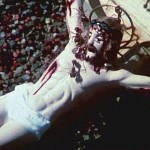

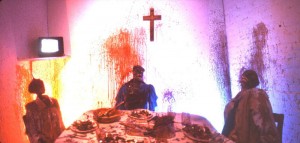
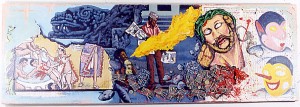
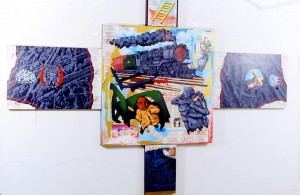
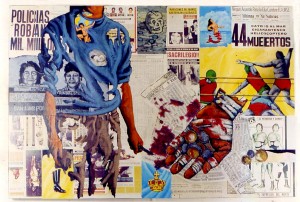
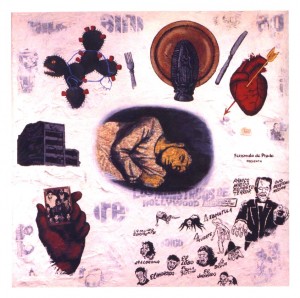
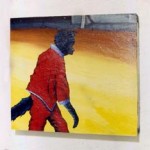
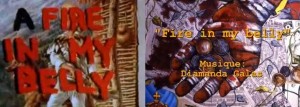
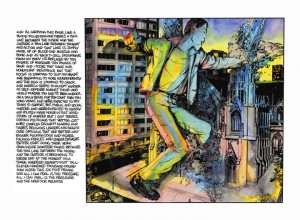
Thanks for writing this, James. Easily the best piece I’ve seen yet on the issue, and a real testament, to me, about how badly the Smithsonian really did fail in their trust — both before and after the controversy.
I was pleased the Warhol Foundation pulled their funding in protest, but I haven’t heard whether there has been a response from the Institution. Does anybody know?
Pingback: Tweets that mention Wojnarowicz’s Apostacy « The Hooded Utilitarian -- Topsy.com
James: I found your piece, especially when you described watching the film A Fire in My Belly, gripping, which is how I would describe Wojnarowicz’s work in general. Everything I see and read about him changes me. Your comic, Seven Miles a Second, with Marguerite Van Cook, had a great influence on me when it was first published and remains not only one of the best tributes to Wojnarowicz’s work but also, for me, one of the top graphic novels ever published by DC under their Vertigo imprint.
Thanks James for an incredibly comprehensive piece on the “David problem.” Pat and I were laughing the other day that David wishes he got this much publicity when he was alive. If there is a heaven, or something like it, he’s cracking up up there.
Thanks for this great and informative piece, it adds important analysis and biography to the discussion of David’s work. I recently screened an excerpt (yes!) of another of David’s films, BEAUTIFUL PEOPLE, at a screening at White Columns in conjunction with the recent ACT UP show. It’s a silent, half hour work also available for screening at the Fales Collection at NYU. Like FIRE IN THE BELLY, these are both timeless works, of their time. And they both are funny too, it should be added. The sense of humor in David’s work should not be forgotten!
Good piece, James: anger in tranquillity.
I, too, like David, feel a rage against the Roman Catholic Church stemming from mental and spiritual abuse as a child.
As Voltaire said, “Ecrasez l’Infâme!”
Personal and scholarly. Riveting. Grateful for your articulate bringing home the experience, content and intent.
We all miss David, he was one of the real lights of the era.
Stephen
James, Thank you for your wonderful, detailed piece. It brought the East Village scene back to me in a second. It is so important that you corrected the historical mistakes and set the record straight. So hard to do and so necessary.
Just a minor correction for the ‘Sources’ section: the book “David Wojnarowicz: A Definitive History of Five or Six Years on the Lower East Side” was edited by Giancarlo Ambrosino, with interviews by Sylvère Lotringer.
Thanks for this! Your text answers so many questions about “A Fire in My Belly” and adds much needed complexity to an over-simplified issue. I wonder if the video was removed from Hide/Seek precisely because it was not the artists’ own voice but an altered version? Or was it because of the religious content? Probably we will never know. However, the NPG’s elusive responses suggest that it was in fact due to pressure from the right and not from any concern with presenting the artist’s voice with veracity.
James,
Thank you so much for your insightful article, I am very glad to see some of the issues around this work be clarified. I was confused when I first saw the video with its accompanying soundtrack, because the images used in Fire in My Belly also appeared in the four videos for ITSOFOMO (In the Shadow of Forward Motion), my collaboration with David from 1988-89. Therefore I expected to hear my music and David’s spoken word instead of either soundtrack that was provided. ITSOFOMO will be screened at the Tate Modern along with Fire in My Belly in January.
I completely agree with your assessment of David’s art and its “greater global view”. David was interested in the mysterious underpinnings of religion, sexuality, politics, and other social phenomena. While he did not recoil from the controversy which his works generated, he did not make the work with that intention primarily. His approach to art was much more poetic and timeless than that.
The ICA in Boston is showing two version of “A Fire in My Belly” – which appear to be original except they are silent. Would someone clarify that even silent versions of the film are edited versions?
Wonderful piece, James. With all the revisionist blather that has been written about not only about “Fire”, but about David himself, it is indeed crucial that such information gets out there. Bravo!
James, this is the most truthful, informed and sincere text I have read on David and on “A Fire In My Belly” since the whole censorship mess began. Congratulations. I myself have covered the controversy several times on my post.thing.net blog, but never from the “inside”. You and Marguerite were privileged to collaborate with David while he was still alive, and your insights benefit from this working relationship.
Many of the pieces I have read recently suffer rather than benefit from hindsight. However well intentioned, they tend to limit David to his AIDS activism, to make him an ACT UP poster boy. Thanks for presenting the total picture. While there is no denying the effect of the epidemic in galvanizing David’s attention, sharpening his acerbity and crystallizing his imagery, his “complex interiority” was already well formed before AIDS became an unavoidable presence in his life. The Mexican imagery which forms the basis of “Fire In My Belly” is informed by a love/hate relationship with his native Catholicism, with the Church’s betrayal and hypocrisy, with the “crisis of faith” you perceptively examine above.
The forces of repression and reaction might think they have won a round in the culture wars. But ironically, the unintentional effect of the censorship has been to focus a belated and long overdue reassessment of Wojnarowicz’s life and work. Your article is an essential part of this effort.
Pingback: James Romberger on David Wojnarowicz - 1-954-270-7404
Dear James,
As the person who was called upon to quickly write
a speech defending “our collaboration” (?!) FIRE IN THE BELLY,
after being told it was inspired by my work, I was grateful
to read your piece.
I never knew David to be inspired by my work and I never
knew where the video came from, but so many people
have used music from PLAGUE MASS,that, liking him, I thought,
“Well this is a proper use of it. I am happy we are joined
somehow since we never met.”
Since then there has been so much disinformation that
my current work has been completely interrupted, as the
persons who put our works together were not forthcoming,
but it has been showed many times and then silenced many
times, as not being the original. It appears that the “original”
has been heard only by you and a few others.
When people take a work of a deceased artist and appropriate
it to squeeze into a “likeable” format, THEY are playing
with fire and bringing victims with them.
I look forward to talking to you sometime.
This is a magnificent article and acquaints me with David’s
work. I still have NO idea whether David knew anything
about my work whatseover, after all has been said and done,
and it is does not matter. I am alive. I have many years to
work. If we were joined by Providence, I was the lucky one.
Diamanda
David Wojnarowicz remains an extremely important artistic voice from a moment of crisis, as all these responses (from brilliant fellow luminaries) testify. The Church can’t thrive by continuing to police its institutional boundaries with the anxiety of a neurotic dog. There’s no reason that statements like Wojnarowicz’s can’t be used to critique and redirect from within the Christian community.
Also, just… what an excellent essay. Thanks.
@Diamanda so glad u r still very active / fire lite of dis world
What is amusing is the insistence of the Fales Libary that the video that
was censored was “a silent video,” when a very close friend said that
the original had sound on it that David himself did, and the closest in
truth to that was the youtube version, which the Fales Library have been
complaining about.
HATE SPEECH means the combination of video and audio,”WHEN ANY MAN HATH
AN ISSUE OUT OF HIS FLESH, BECAUSE OF THAT ISSUE HE IS UNCLEAN. EVERY BED
WHERE ON HE LIETH IS UNCLEAN….AND THE PRIEST SHALL LOCK UP HE THAT
HATH THE PLAGUE, HE SHALL CARRY HIM FORTH TO A PLACE UNCLEAN…HE SHALL
SEPARATE HIM IN HIS UNCLEANJESS. THIS IS THE LAW OF THE PLAGUE,
TO TEACH WHEN IT IS CLEAN AND WHEN IT IS UNCLEAN.”
That is the text Galas chose for her libretto in 1985, chapter 15 of Leviticus.
But this is from the most famed performance work of the AIDS EPIDEMIC,
PLAGUE MASS. And Galas was never contacted about this work, nor did the
Fales Gallery once attempt to remove it from youtube.
This reminds me of the story i heard about Bernard Hermann and Alfred
Hitchkok. “No sound for the shower scene.” Hermann ignored him.
Noone will forget the violins and the bass in in Psycho. It revolutionized film.
Don’t you find it interesting that ART FOLKS chose to say the unauthorized
Galas version was too incendiary, yet the curator of the work added a pallid
little ACT-UP demonstration to it, to try to imitate the Galas work
chosen by filmmaker von praunheim in SILENCE=DEATH?
James Romberger would you mind if we used some of these words in our NPG protest?
My friend and I are opening “The Museum for Censored Art” in a trailer infront of the NPG next week, and I think a lot of this would be rather poignant if displayed with the video.
http://dcist.com/2011/01/museum_of_censored_art_green_lighte.php
Update on the search for the original soundtrack of “A Fire In My Belly.”
The film was shot on Super-8, which has no sound; a soundtrack would have been dubbed in later. Ben Neill wrote (above) to suggest that he did the original soundtrack, as he did for ITSOFOMO, but dated his sessions with David as 1988-89, too late to be what I saw. Then, Doug Bressler of 3 Teens Kill 4 sent me tapes that seemed promising. He recorded them with David in 1986 for a then-untitled film with Mexican content. Doug never saw the results of his collaboration.
I contacted Tommy Turner who had accompanied David on the Mexican trip. He told me that he also had seen David’s original film. Doug had asked me to not forward his tapes, so Tommy came over to my apartment to listen to the two alternate soundtracks. We listened while we watched the online versions with the sound turned off. Tommy recalled many of the shots directly, since he was with David while they were filmed.
Neither soundtrack is what Tommy or I remember, but they have some elements that fit. The original was dense and noisy, texturally more like the version on Youtube with Diamanda Galas. One of Doug’s tapes was dense and noisy, but…not right. We agreed that the Mexican singing and Spanish language in the other tape seems to go well content-wise and lengthwise with the silent 14-ish minute version put up online recently from the Fales collection, however, it would have been overlaid with other tracks to achieve the density of noise that both Tommy and I recall.
If Doug’s Mexican tape, as is, is added to the silent Fales footage, it becomes another version, more of a travelogue, with more driving shots, much slower pacing and a sparse soundtrack, consisting mostly of an entire song sung in Spanish and some incidental noise…it doesn’t feel finished. Perhaps, if Doug multitracked his two tapes, it might sound like what I remember.
The 14 minute version sold to MOMA that is now in circulation is silent, unedited and overlong. The nature of film and particularly of David’s efforts in that medium is that his editing is the single most important aspect of the work. Seen without David’s editing and sound which contextualized the images and made viewing the film such an overwhelming experience for me, the MOMA version seems a reverse travelogue and makes David seem racist. Noah Berlatsky noted the MOMA version’s feel of ethnic appropriation and negative exoticism, and I can’t dispute his take…the film does not work in this form. Is Wojnarowicz’s legacy served by the sale and exhibition of unfinished works that the artist may not ever have wanted shown publicly, presented as finished work, or by the public display of all of his personal effects that are archived for academic purposes—raw footage, notebooks, sketches and doodles he made while talking on the phone? One expects more from an institution such as MOMA.
As it turns out, I made a mistake in my piece. The Fales raw footage has a shorter version added on, edited by David, that includes the sewing lips footage that was also used in Silence=Death. The S=D images were adapted from the original A Fire In My Belly. This reverses my previous objection to what I believed was the Smithsonian curators’ visual editing of the Fales footage to make the Smithsonian version. The curators’s actual misguided addition was the sound of the ACT-UP demo.
Based on the information at their disposal, Fales has stated that the film was silent. But while David’s notes for the film in the Fales collection have no indications for sound, he was consistent in that he incorporated noise and music into his installations and his films—-and Tommy and I both definitely remember a soundtrack.
We recently learned that the short Youtube version with Diamanda Galas’ music was edited by David himself, working with Marion S. And so, that version now stands as the most valid.
Could you link to the version that you think is the most valid one, James?
http://www.youtube.com/watch?v=0fC3sUDtR7U
Dear James,
Thank you for your research and your candor here.
As you know from my message above, I have been
caught in the middle of a rock and many repulsive soft places,
notably the SILENT ( to me and marion s in paris)
paunches of the greedy, wishing to sell rough
drafts as “originals” but sending out the finished product
to TRANSFORMER by mistake and then pull the version
created by David and Marion from two NYC galleries
after the press releases were written. Larceny in the
Catholic Church and the House. Well, sure, but we KNEW
THAT ALREADY, those of us who have known for years
about the babies buried in the walls of the monasteries.
The fables and foibles of the comfortable, living on grants
provided them by the DEAD and soon to BE DEAD are
far seedier to my mind.
To think that I who charged Coppolla a bundle for only
one of the sections of DRACULA, would NOT notice
how well the the music and the visual work cohere in FIMB
when i am an infamous bitch to all filmmakers
until they get it right, is a laugh.
Composers are taught to believe with their OWN ears,
not those of the ministry of necrophiles who try to rescore
with the sounds of chipmunks on parade.
Good ole boys are good ole boys whether they are straight,
homosexual, white or blackm and I think the corn
is just about to crack.
Diamanda Galas THE EVIL BITCH, FIST, AND PARTY OF ONE
Galases self aggrandizing and pompous response is not impressive.
Museums, galleries and officiates of the estate have denied Galas any access to the publicity of ‘Fire’. Consider the public actions of this musician since her “response” to ‘Fire’ and the former supporters of her work who will no longer support it and the many in the gay community who may be the silent majority but do not agree with her recent public stunts. A defamation attack against another artist, a friend, ex-lover or unknown relation which last checking mentioned a criminal investigation against Galas.Now posted is an item that Galas is again under investigation for cyber stalking and death threats. A pretty involved investigation by the nypd and fbi. Do I agree with Aids denialists? Definitely not at all. Do I think someone whose opinions I don’t agree with should have a public casting call for her grisly murder so that Galas can turn it into a snuff film for her record label? No. She gives everyone who was on the frontline for decades a terrible name. The item: http://deanesmay.com/2011/01/19/abuse-and-bullying/
In light of all of Galases stalking and murder plots, does the -Soon to be dead” quip imply more.
“Sounds of chipmunks on parade”. Here Galas insults David, whose voice is the voice heard above everyone else in the ACT UP demo she writes about.
Maybe time to consider the bigger picture of Galases “give me attention” temper tantrums and public histrionics which may be cute when pulled off by a 12 year old at a birthday party or simply annoying when pulled off by a 30-something pop-star yet is usually avoided by adults in the professional world.
David Wojnarowicz made the video and edited it specifically to work with the Diamanda soundtrack.
Accusations of grandstanding in response to the legal threats made against her are spurious and misdirected. I personally saw Galas records at David’s house and have been told by his longtime friend and collaborator Marion. S. that this is the case. The footage with that sound track was shown at Lace in 2007.
Here is the link. http://www.artleak.org/winter07events.html
They hate the Foo Fighters!
Marguerite…sorry but…what’s this all about? I feel like I’ve come in halfway through. Googling isn’t helping….
Galas and some of her fans on Facebook used some fairly brutal imagery (both linguistic and visual) to mock Celia Farber. She sees it as more than mocking, as an example of cyber-bulling/-stalking/-threatening, and is pursuing a legal remedy. Go here for her post with images.
Thanks Marguerite, and suck my ass Gigi Rossi, you colossal
anal wipe.
HAHAHAHAHAHAHAHAHAH. I loved that facebook last summer
It was a master stroke. Do you think my skin crawls whenever
a moron insults me? Guess again, stupid.
Poor Celia. Thusfar she has survived the heat of the summer
and winter months– wherever she is hiding. What a troll.
Any AIDS activist who is a friend of Celia’s is already dead by
now, you imbecile.
POOR little turnip. She thinks writing my gang writng nasty things about her
embedded ass is indelicate? How about all the dead bodies
she is responsible for? The FOO fighters? He is a drummer
without a brain. I was raised on Buddy RIch. Now we have
breeders with chopsticks talking about viral duplication. Oh dear. Oh mommy. Oh SHUT UP, will ya? Me and Marguerite
are busy.
will ya?
I hate the Foo Fighters, too, but Grohl’s a nice fellow. Rich was a real dick, but a great drummer. Hmm.
When the water reaches sea level, girl, hit me baby one
more time. We are talking about AIDS disinformation.
I could give a fellating fuck about nice. Give me
an honest homophobe over a dumbass liberal DARTH VADER
bearing crystals on the bodies of the soon- to- be- dead.
“Bless you my child, while the rich white boys on WALL STREET
were taking anti-virals ‘ just in case’ they stayed alive long
enough to get the protease cocktails, YOU, sainted brother,
die unblemished by the crimes of the marketplace, but
annointed by ME.” JESUS FUCK ME. What a bloody weekend.
Fair enough.
uh… bright sun, a friendly kiss, and M&M cookies
“Galas and some of her fans on Facebook used some fairly brutal imagery (both linguistic and visual) to mock Celia Farber.”
BINGO CHARLES! Yes we had a conversation on facebook where we mocked Farber. That was the start and the end of it. Any accusation of stalking or making death threats is utter bullshit. But then what would one expect from people who have made a career out of promoting a manufactroversy?
Let me be clear on a number of points.
The images that I produced were to do with me and me alone, they had nothing to do with Ms Galas. These images are a set that I started doing in 2008. So really are nothing new and only now getting the attention because it suits certain people who like to play the victim. They are being linked to the facebook conversation out of convenience.
It is deeply hypocritical of any HIV denialist to complain about the use of blood as a form of protest when HIV denialists famously threw fake blood over Margaret Fischl and Paul Volberding at the 1996 International AIDS Conference.
Do I hate Celia Farber? Yes. Do I wish to see Celia Farber dead? No. The truth of the matter is that Celia Farber is her own worst enemy in the way that she posts on line and then removes things thinking that nobody has noticed. In that regard she is very helpful in making HIV denialists look like the conspiracy mongers that they are. Simple as.
As for the Foo Fighters the reason that I object to them so strongly is that in early 2000 they did some benefit gigs for Christine Maggiore’s denialist organisation. Later in the year Maggiore flew to the Durban International AIDS Conference and hung out with Thabo Mbeki who started parroting her “No ARVs to prevent mother to child transmission” bullshit. This has been shown to have resulted in 35,000 children being born, in South Africa, with HIV when it could have been prevented. Of course I am not saying that the Foo Fighters are responsible for this, however they supported Maggiore and she should take a certain degree of credit for such horrendous public health policies.
HIV denialists exploit vulnerable people and undermine public health and they should be exposed for their crankery at every opportunity.
oy vey zmir diamanda galas is a mess and a cyberpath
this is funny
“[The blood-splattered images] are being linked to the facebook conversation out of convenience.”
Duly noted and good to know. But, on the other hand, y’all should consider that expressing hate with violent, bloody rhetoric in a time of abortion clinic assassinations and the like does give the target of said rhetoric grounds for worry. Or consider Palin’s use of the gunsight symbol to mark supporters of the healthcare plan.
Joe, I’ve deleted your comment. You either need to be cleverer in your insults or else more civil. I’m not going to have the thread degenerate into a series of one line obscenities.
Thanks Celia. Got any hot viral load recently
up them sainted panties of yours?
You have no idea how nasty I can get.
But I am now bored, seeing as how
the insults are coming from barbie’s fan site.
Gee go to the Modern if you want to Sleazy’s
filming of my DOUBLE BARRELED PRAYER
and see what is is like to be an artist who
is NOT edited/censored and FUCKED by
the estate simply because she is ALIVE and
re-edited all the footage after the record
company “thought” it was finished. THen i sent it
back to Sleazy,my collaborator and the first
AIDS filmmaker, and we laughed. In 88.
I KNOW baby what it is like to be screwed by the people
who are supposed to have your back but just
want your money. So i have david’s back, not yours.
What they trolled out in david’s name is a completely
silent track at the modern without EVEN the bouncy
new swim team that jonathon curated, like meat.
I get it you think I am a rich pop star trying to ride the pony
to the bank off a a dead artist? Are you crazy, motherfucker?
You want a good necro song, listen to this one—
” I LOVE THE DEAD” by alice cooper. michael told me
to cover that years ago when things got nasty and I was on the HEP C protocalls. Maybe I will do it now
and call it Bitches Brew, or Fables from the Crypt.
Shit? You ain;t dug deep enough down there, sister cornhole.
First comes the shit. Then comes the diamonds.
Oh baby got to go. I got a film coming out in april
Is that REAL self promotion good enough for you?
Okay out of respect for James I will stop enjoying myself.
This is too much fun playing sandpiles with you all.
x
I am reading here and didnt see a comment by Joe -assume it was removed before I saw it.
Noah wrote:
“I am not going to have this thread degenerate into a series of one line obscenities.”
Youve got to be kidding, brother. The comments of Diamanda Galas should be tossed out in that case. Galas seems to have spent her day writing halfcocked insults and obscenities in response to a serious discussion. If Diamanda Galas is given a free pass to act like a lunatic while everyone else is going to be censored please clarify so we know what kind of forum this is. Geesh no wonder the estate and gallerys put a muzzle on her.
Self aggrandizing is right whoever said that. There Diamanda Galas is again right after what I just wrote. She is back with with another comment about how great she is. This is really pathetic. Hey Diamanda, the 1990’s called. They said they are tired of you hanging onto them so tight. They said they have other one hit wonders like Lita Ford and The Bangles who need some room so if you could please let go a little theyd appreciate it. The 1980s rang in too and said that whole evil bitch thing didn’t work out for you thirty years ago and it isnt working now.
Heated argument is fine; disagreeing with whoever is fine. Posting an obscenity with basically no other content will be deleted. That seems like a fairly low bar to get over.
http://icpbardmfa.wordpress.com/2010/12/22/faculty-member-david-deitcher-on-icps-david-wojnarowicz-panel-12-16-2010/
PLEASE READ THIS ARTICLE
HISTORY LESSON
“Joe, I’ve deleted your comment. You either need to be cleverer in your insults or else more civil. I’m not going to have the thread degenerate into a series of one line obscenities.”
Anal wipe passes the low bar, but not shit? C’mon, Noah.
Re: the article posted by Unclean:
It would have been helpful if Marvin Taylor of NYU’s Fales Library had consulted with myself or Tommy Turner, since I believe he has been informed that Tommy and I actually saw the original version of the film in question, before he issued a “factsheet” that repudiated the Youtube version. Wojnarowicz himself did the edit of that version with Marion S. It was David who included Diamanda’s music, without her permission, so if anything she is the offended party here. The problem is that the Fales Library can only judge the “facts” by the materials in their possession.
Memory is a funny thing. After we exhibited the original painting “Street Kid”, I only saw the reworked version once— in my piece above, I recalled that David had added enough vines to nearly obscure the original painting, but here it is, in PPOW’s upcoming show:
http://ppowgallery.com/exhibition.php?id=89#image1984-hi
Uland asked to have his comments removed from this thread.
I’ve deleted the slew of anonymous, off-topic nonsense. I’m also going to close the thread, at least for a time.
Pingback: Wojnarowicz’s Apostasy | James Romberger